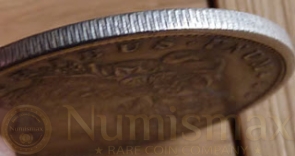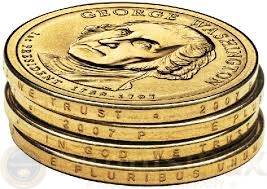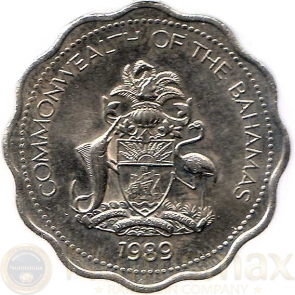 Heads or tails? What more do you need to know? Actually, there’s a lot more to it. In this series on Coin Anatomy we will take a look at what all of the parts of a coin are, what goes into making coins, and some other cool stuff that will help step up your numismatic acumen. First, we’ll start with the basics. How many sides does a coin have? Most people say two without really thinking. Actually, a coin has three sides: the obverse or “heads side”, the reverse or “tails side,” and The Edge. When you pick up a coin the side that you should first focus on is the edge (after all, you should be picking the coin up by its edge), so we’ll start there.
Heads or tails? What more do you need to know? Actually, there’s a lot more to it. In this series on Coin Anatomy we will take a look at what all of the parts of a coin are, what goes into making coins, and some other cool stuff that will help step up your numismatic acumen. First, we’ll start with the basics. How many sides does a coin have? Most people say two without really thinking. Actually, a coin has three sides: the obverse or “heads side”, the reverse or “tails side,” and The Edge. When you pick up a coin the side that you should first focus on is the edge (after all, you should be picking the coin up by its edge), so we’ll start there.
Plain, reeded, lettered, scalloped, and rough, edges come in many different forms. Plain edges are just that, plain, like the edge of a Lincoln cent or Jefferson nickel. Plain edges are easily nicked, so be extra careful touching the edge if you think you have a 69 or 70 grade coin on your hands.
Reeded edges are indicative of the silver coins in US numismatics before 1964 with the exception of the half dime. A helpful hint when looking for 90% silver coins in a large group of coins is look at the edge. The edges of the silver coins are just that, silver. The edges of the post silver coins show the clad layers and have a prominent copper colored center.
 Many coins (some early silver dollars and $20 gold pieces in particular) have lettered edges. Typically, the lettering is the motto, “In God We Trust,” but not always. Sometimes there are just stars or “United States of America,” or a slogan written in Latin. No matter what is on the edge, it is worth paying close attention to when inspecting a coin for purchase. Edges, lettered edges in particular, are tough to counterfeit. Knowing what the real ones look like can save you a lot of money and heartache. Edges are important. As a matter of fact, there was such demand from collectors that wanted to see the edges of their certified coins, that the major grading services changed their holders a few years ago to be able to see the edges of all of their certified coins.
Many coins (some early silver dollars and $20 gold pieces in particular) have lettered edges. Typically, the lettering is the motto, “In God We Trust,” but not always. Sometimes there are just stars or “United States of America,” or a slogan written in Latin. No matter what is on the edge, it is worth paying close attention to when inspecting a coin for purchase. Edges, lettered edges in particular, are tough to counterfeit. Knowing what the real ones look like can save you a lot of money and heartache. Edges are important. As a matter of fact, there was such demand from collectors that wanted to see the edges of their certified coins, that the major grading services changed their holders a few years ago to be able to see the edges of all of their certified coins.
Foreign mints have taken the artistic aspect of the edge to the next level compared to the US Mint. Some have scalloped edges, flowery edges, edges with incuse stars, diamonds, cinque-foils, and dots. I am constantly amazed by what I find in foreign proof and mint sets in regards to unique edge design.
 Rough edges are just that, rough. These are the edges found from the early manufacture of coins from ancient rome through much of the colonial era. You might think that there isn’t much to learn from these amorphous edges, but there is. The more round one of these edges is, the more it can be worth (especially when combined with a well centered strike). Second (and once again), it is where you look for counterfeits. We’ll talk more about counterfeits in a different series, but long story short, a cast copy of an ancient coin leaves a tell-tale ridge on the edge of what would otherwise be a random shape.
Rough edges are just that, rough. These are the edges found from the early manufacture of coins from ancient rome through much of the colonial era. You might think that there isn’t much to learn from these amorphous edges, but there is. The more round one of these edges is, the more it can be worth (especially when combined with a well centered strike). Second (and once again), it is where you look for counterfeits. We’ll talk more about counterfeits in a different series, but long story short, a cast copy of an ancient coin leaves a tell-tale ridge on the edge of what would otherwise be a random shape.
Thanks for reading this installment on in our series on coin anatomy, The Edge. In the next installment we’ll talk about the the finer points of the obverse and reverse.


